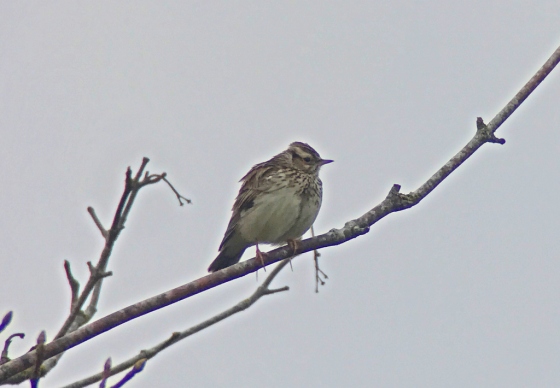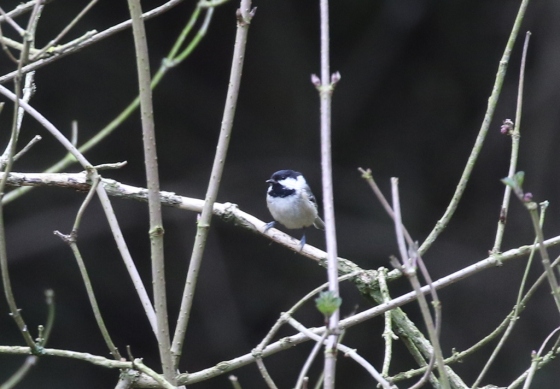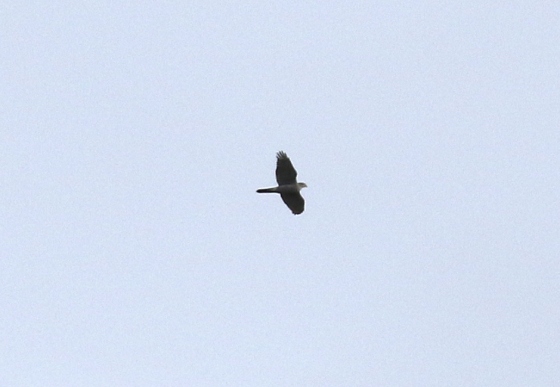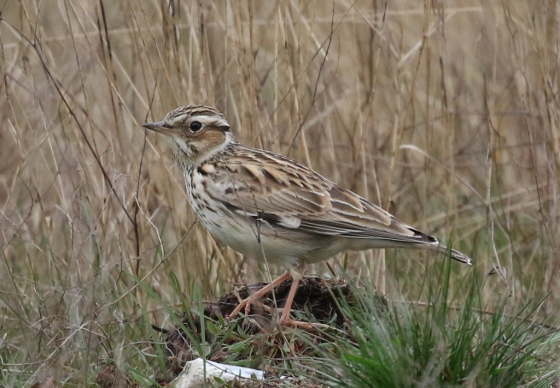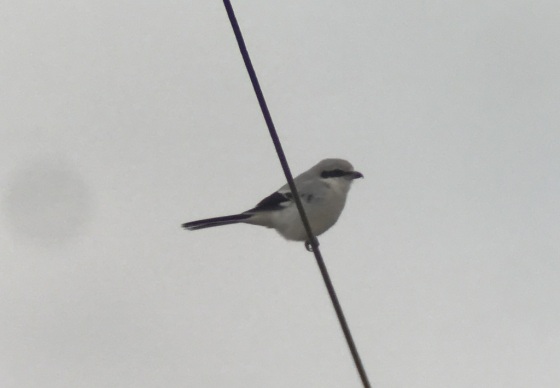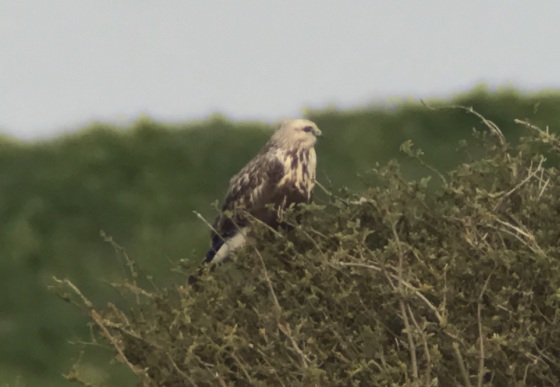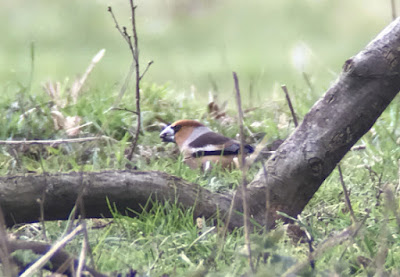08/03/2020 Marcus Nash Winter Tour - Day3/3
Day 3 of our three day Winter tour, our last day today. It was a rather blustery morning, with the winds dropping in the afternoon, and mostly dry and bright - we managed mostly to dodge the showers. We spent the day up on the North Norfolk coast.
Holkham was our destination for the morning.
As we drove up along Lady Anne's Drive, we could see lots of ducks out on the floods on the grazing marsh, mainly wigeon, with a scattering of shoveler, teal and one or two gadwall. We parked at the north end and as we walked up towards the pines, we stopped to admire a smart pair of grey partridge feeding very quietly right by the fence behind the parking attendants' hut.
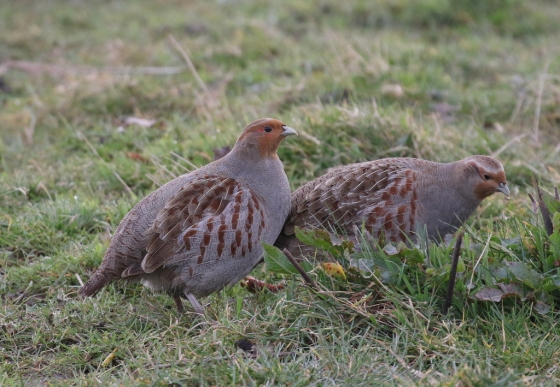 |
| courtesy of Marcus Nash |
There was a blustery wind blowing, so we elected to go round to the hides first, rather than out onto the beach.
As we walked west along the track on the inland side of the pines, there were a few tits calling in the trees. We stopped briefly at Salts Hole, where four little grebes were diving out on the water. A pair of mistle thrushes were out on the grass beyond.
Diverting up onto the boardwalk by Washington Hide, we spotted a great white egret out on the grazing marshes. Its large size was immediately apparent and through the scope we could see its long yellow bill. Way off in the distance, we could just make out a few white-fronted geese over by the road, behind the hedge, but we hoped to see some closer from the next hide.
A chiffchaff was calling in the bushes by the track the other side of Meals House - it would be nice to think it might be an early spring migrant, but it was just as likely an overwintering bird here.
The first thing we saw when we got into Joe Jordan Hide was the lone spoonbill asleep down on the pool below the wood, bright white in the morning sunshine. It did wake up at one point and flash its spoon-shaped bill, revealing that it was an immature bird - it also lacked the shaggy crest of the breeding adults. It then hopped into the shelter of the rushes on the edge of the pool. It was the only one we saw here today, the others possibly hiding from the wind in the trees.
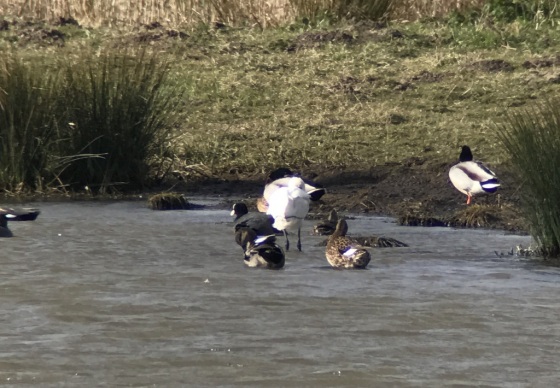 |
| courtesy of Marcus Nash |
There were two more great white egrets out on the grazing marshes from here, feeding together out in a particularly thick clump of rushes. It was amazing that such a large white bird could completely disappear in the vegetation at times.
There was no sign of the large flock of wintering white-fronted geese on the old fort today. Most of the greylags were sleeping out on the marshes and scanning carefully through we did manage to find six white-fronted geese in with them. They didn't hang around though, for no apparent reason waking up and flying off, presumably to find the rest of the flock.
Before everyone got too comfortable, we decided to move on. As we walked out earlier, a runner had mentioned there had been a short-eared owl out on the beach, so we thought we would check in case it was hunting along the north side of the pines.
When we got out into the dunes, there was no sign of the owl, but we did find three stonechats flitting around in the bushes, the single male singing quietly, and several song-flighting meadow pipits fluttering up and parachuting back down.
The large raft of several thousand common scoter which has been in the bay all winter was directly offshore from here today, so we stopped for a quick look through them. The tide was out so, despite them being not too far offshore, they were distant from the dunes and it was very choppy. Marcus did manage to pick out a velvet scoter in with them, but it was impossible to get anyyone onto it in the conditions. More surprisingly, a pair of pintail and a drake shoveler were in with the scoter flock too.
It was more sheltered on the north side of the pines, so we decided to walk back through the dunes. It was a good call as it gave us the chance to scan the beach and saltmarsh on the way.
We picked up a pair of ringed plovers roosting on the shingle, perhaps not for long given the number of dogs running round loose on the beach. Then we picked up five small birds flying round out on the saltmarsh in the distance. As they turned we could see they were fairly pale with contrasting black tails - shorelarks!
We had a quick look at them from where we were - there was a spaniel running around out on the saltmarsh and heading in their direction and we worried they might fly off. Then we hurried over for a closer look. The shorelarks were feeding in the low saltmarsh vegetation, but still remarkably hard to see until they lifted their heads. Then their canary yellow faces and black masks gave them away.
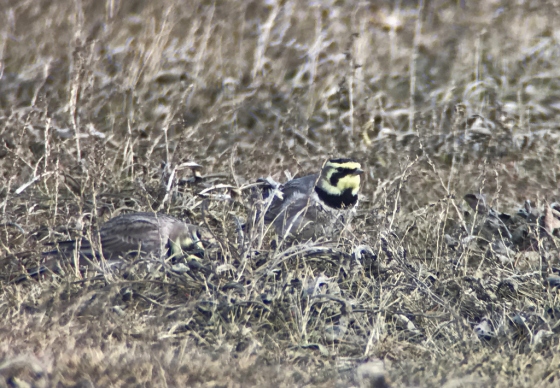 |
| courtesy of Marcus Nash |
When the Shorelarks are not feeding in the cordoned-off area at the other end of the beach they can be hard to find, so it was great that we had bumped into them. By the end of this month, they will probably be off to their breeding grounds in Scandinavia.
Snow buntings were on the target list for the day too, so we walked east to the cordon to see if we could find them there. Some people we passed had said they were on the beach at the far end, so we headed over there first. There was no sign of them on the beach and it was very windy and sand-blasted here. A quick scan of the sand bars produced a few sanderling running around on the beach.
Another person further back on the inland side of the dunes waved to us, and as we started to walk over we realised he was watching a small group of snow buntings which were feeding between us in a sheltered gap in the dunes. We had a good look at them as they fed. There were six of them at first, but gradually they ran up and disappeared into the dunes.
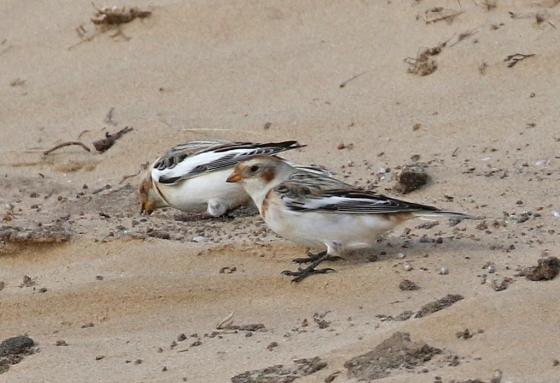 |
| courtesy of Marcus Nash |
It was then heads down for the walk back, into the wind. It was a relief to get to the Gap and the shelter of the pines. It was time for lunch now, so we took advantage of the Lookout Cafe to get a welcome hot drink and some food, and use the facilities.
The wind seemed to have eased a bit after lunch. It was bright and sunny now and we commented how there was no sign of any of the forecast showers - indeed the forecast had changed and was now not predicting any until mid afternoon.
We set off west, but stopped where we had seen the white-fronted geese very distantly from the other side early this morning.
There were lots of greylags and Egyptian geese in the field, and in with them were still at least 50 white-fronted geese. We parked and got out, being careful not to spook them, and got them in the scope. We could see the white surround to the base of their bills and distinctive black belly bars.
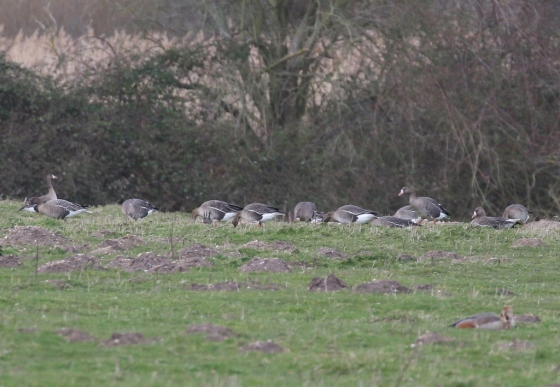 |
| courtesy of Marcus Nash |
Thankfully, we had all had a chance to get a really good look at the white-fronted geese when it started to spit with rain. How ironic, given the change to the forecast! We could see some dark clouds now out to the west, so we hopped back into the minibus and drove through a sharp shower and back out into the sunshine.
As we drove through Titchwell village, we noticed a barn owl hunting the grassy field by the road. We had just pulled up and were about to get out to watch it, when a young common gull which was flying over swooped down straight at it. The barn owl dropped sharply, clearly as surprised as we were at this act of unprovoked aggression! It then turned and made a zig-zagging beeline for the hedge, where it dropped down under the bushes in the bottom, looking round nervously. After convincing itself that the coast was clear, it flew out of the back of the hedge and straight into the back of the wood beyond.
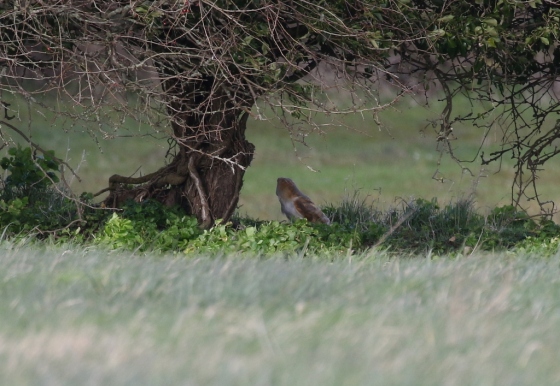 |
| courtesy of Marcus Nash |
Carrying on past Titchwell, we stopped next at Thornham Harbour.
There was no sign of any twite around the old coal barn. A black-tailed godwit in the harbour channel was our first of the weekend and a curlew was feeding on the saltmarsh opposite. With the wind having dropped, we decided to have a quick walk up to the corner of the seawall to see what we could see.
There were plenty of common redshank out in the muddy channels and one or two more curlews. A small group of linnets kept flying up from the vegetation in front of us and a little egret was on the edge of the saltmarsh just below the bank. Scanning further out in the harbour channel, we picked up a much paler wader. Through the scope, we could confirm it was a spotted redshank in silvery-grey non-breeding plumage. We could see the prominent white supercilium bridging the base of the bill, which was long and needle-fine at the tip.
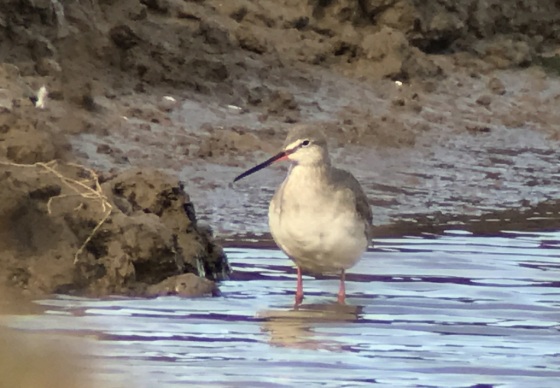 |
| courtesy of Marcus Nash |
Spotted redshanks winter in very small numbers here - they are mainly passage migrants, passing through in spring and autumn. There have been two commuting between Thornham and Titchwell this winter, but they disappear into the tidal creeks and can be very hard to find at time.
We headed round to Titchwell next, to finish the afternoon.
As we got out of the minibus and stopped to use the facilities, we heard the distinctive calls of Mediterranean gulls and looked up to see a succession of birds flying in and out overhead.
Checking in at the Visitor Centre, there had been no sign of any woodcock today but we were told that there were three red-crested pochard on Patsy's Reedbed. We went that way first and quickly found them out on the water. The two drakes were already looking resplendent in the afternoon sun, but then they started displaying to the female, with their bright orange punk haircuts raised. One of the males was more successful, and we watched the pair mating while the second drake played gooseberry!
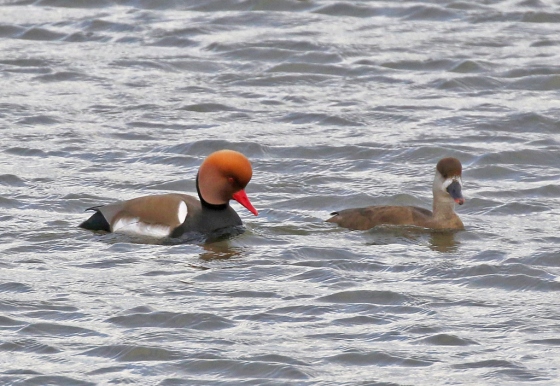 |
| courtesy of Marcus Nash |
Otherwise, there were not many other ducks on here today.
Two or three marsh harriers were hanging in the air out over the reedbed or over towards Brancaster.
A Chinese Water Deer appeared on the edge of the reeds briefly.
Back round on the main path, there were a few common pochards on the reedbed pool.
A cetti's warbler shouted from the bushes in the reeds.
The water level on the freshmarsh is very high again and there was no sign of the shallow islands which had started to be exposed a couple of weeks ago.
There were lots of avocets trying to find any shallow water in which to feed and most were gathered right in front of Island Hide, so we went in for a closer look. They were right up to their bellies in the water and either swimming or could just get their feet onto the bottom to kick themselves up to try to reach the mud with their bills.
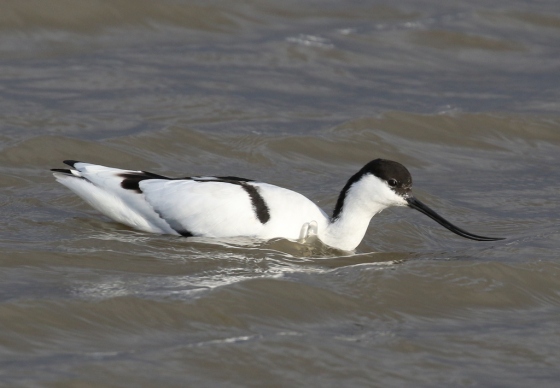 |
| courtesy of Marcus Nash |
There was very little else on the Freshmarsh apart from the gulls, which have taken over the large 'Avocet Island' again this year, where the Avocets are supposed to nest. We walked round to Parrinder Hide for a closer look at some Mediterranean gulls. Another group of avocets flew in over the saltmarsh, presumably feeding at the moment out in the harbour channels at low tide, and more were roosting in the water where one of the islands would normally have been.
Inside the fenced-off 'Avocet Island' we could see lots of gulls, mostly black-headed gulls, claiming the ground ahead of the breeding season. In with them we counted at least 40 Mediterranean gulls, all adults coming into breeding plumage with white-speckled jet black hoods contrasting with bright white eyelids, bright red bills and white wing tips. It was good to compare the two species side by side.
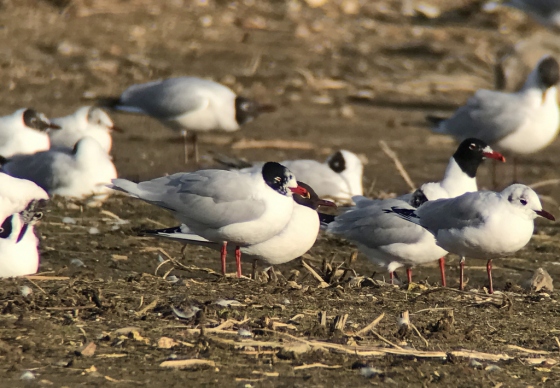 |
| courtesy of Marcus Nash |
Otherwise, all we could find here today was a single knot which was roosting on one of the few taller bits of island which were above the water. There was no sign of the water pipit again, perhaps not a surprise with so little of the water's edge exposed. We decided to head out towards the beach.
The tide was in now and with a bigger tide today, Volunteer Marsh was under water. As we walked past, we noticed a couple of little groups of teal next to the path. The drakes were looking stunning in the afternoon sun and they were calling and displaying.
We walked out to the Tidal Pool to see if we could find some more waders. There were several godwits on here - mostly black-tailed godwits, with some starting to show some brighter rusty feathering as they begin to moult into breeding plumage.
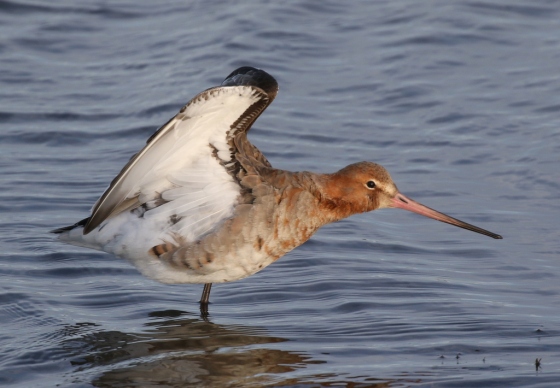 |
| courtesy of Marcus Nash |
We managed to find a single bar-tailed godwit feeding on the edge of the mud - paler and more heavily streaked above that the black-tailed godwits - but surprisingly there were not more roosting here given the tide was in.
On the spit where they normally gather there were just two grey plovers today. There were still quite a few oystercatchers on the island, together with several turnstones.
The tide was right in and there was next to no beach left. We had a quick scan of the sea, but all was quiet here - a lone seal and a single distant great crested grebe.
As we started to make our way back, a skylark was dust bathing on the path. It was very confiding and seemed reluctant to stop what it was doing to make way and let us come past.
Unfortunately, we had to get back now, so those with longer journeys back could get away. As we made our way back east along the coast road, a barn owl was hunting where we had seen the one earlier, but this time a different paler bird.
What a trip - so refreshing!











